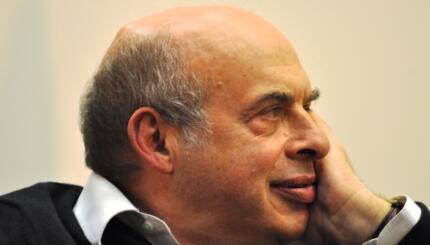Reprinted with permission from The Simon Wiesenthal Center.
Simon Wiesenthal was born on December 31, 1908 in Buczacz, in what is now the Lvov Oblast section of the Ukraine. When Wiesenthal’s father was killed in World War I, Mrs. Wiesenthal took her family and fled to Vienna for a brief period, returning to Buczacz when she remarried. The young Wiesenthal graduated from the Gymnasium in 1928 and applied for admission to the Polytechnic Institute in Lvov. Turned away because of quota restrictions on Jewish students, he went instead to the Technical University of Prague, from which he received his degree in architectural engineering in 1932.
The Holocaust

In 1936, Simon married Cyla Mueller and worked in an architectural office in Lvov. Their life together was happy until 1939 when Germany and Russia signed their “non-aggression” pact and agreed to partition Poland between them; the Russian army soon occupied Lvov, and shortly afterward began the Red purge of Jewish merchants, factory owners and other professionals…

Help us keep Jewish knowledge accessible to millions of people around the world.
Your donation to My Jewish Learning fuels endless journeys of Jewish discovery. With your help, My Jewish Learning can continue to provide nonstop opportunities for learning, connection and growth.
Early in 1942, the Nazi hierarchy formally decided on the “Final Solution” to the “Jewish problem” — Annihilation. Throughout occupied Europe a terrifying genocide machine was put into operation. In August 1942, Wiesenthal’s mother was sent to the Belzec death camp. By September, most of his and his wife’s relatives were dead; a total of eighty-nine members of both families perished.
Because his wife’s blonde hair gave her a chance of passing as an “Aryan,” Wiesenthal made a deal with the Polish underground. In return for detailed charts of railroad junction points made by him for use by saboteurs, his wife was provided with false papers identifying her as “Irene Kowalska,” a Pole , and spirited out of the [Ostbahn labor] camp in the autumn of 1942. She lived in Warsaw for two years and then worked in the Rhineland as a forced laborer, without her true identity ever being discovered.
With the help of the deputy director, Wiesenthal himself escaped the Ostbahn camp in October 1943, just before the Germans began liquidating all the inmates. In June 1944, he was recaptured and sent back to Janwska where he would almost certainly have been killed had the German eastern front not collapsed under the advancing Red Army. Knowing they would be sent into combat if they had no prisoners to justify their rear-echelon assignment, the SS guards at Janwska decided to keep the few remaining inmates alive. With 34 prisoners out of an original 149,000, the 200 guards joined the general retreat westward, picking up the entire population of the village of Chelmiec along the way to adjust the prisoner-guard ratio.
Very few of the prisoners survived the westward trek through Plaszow, Gross-Rosen and Buchenwald, which ended at Mauthausen in upper Austria. Weighing less than 100 pounds and lying helplessly in a barracks where the stench was so strong that even hardboiled SS guards would not enter, Wiesenthal was barely alive when Mauthausen was liberated by an American armored unit on May 5, 1945.
Documenting War Crimes
As soon as his health was sufficiently restored, Wiesenthal began gathering and preparing evidence on Nazi atrocities for the War Crimes Section of the United States Army. After the war, he also worked for the Army’s Office of Strategic Services and Counter-Intelligence Corps and headed the Jewish Central Committee of the United States Zone of Austria, a relief and welfare organization. Late in 1945, he and his wife, each of whom had believed the other to be dead, were reunited, and in 1946, their daughter Pauline was born.
The evidence supplied by Wiesenthal was utilized in the American zone war crime trials. When his association with the United States Army ended in 1947, Wiesenthal and thirty volunteers opened the Jewish Historical Documentation Center in Linz, Austria, for the purpose of assembling evidence for future trials. But, as the Cold War between the United States and the Soviet Union intensified, both sides lost interest in prosecuting Germans, and Wiesenthal’s volunteers, succumbing to frustration, drifted away to more ordinary pursuits. In 1954, the office in Linz was closed and its files were given to the Yad Vashem Archives in Israel, except for one–the dossier on Adolf Eichmann, the inconspicuous technocrat who, as chief of the Gestapo’s Jewish Department, had supervised the implementation of the “Final Solution.”
While continuing his salaried relief and welfare work, including the running of an occupational training school for Hungarian and other Iron Curtain refugees, Wiesenthal never relaxed in his pursuit of the elusive Eichmann who had disappeared at the time of Germany’s defeat in World War II. In 1953, Wiesenthal received information that Eichmann was in Argentina from people who had spoken to him there. He passed this information on to Israel through the Israeli embassy in Vienna and in 1954 also informed [Zionist and Jewish communal leader] Nahum Goldmann, but the FBI had received information that Eichmann was in Damascus, Syria. It was not until 1959 that Israel was informed by Germany that Eichmann was in Buenos Aires living under the alias of Ricardo Klement. He was captured there by Israeli agents and brought to Israel for trial. Eichmann was found guilty of mass murder and executed on May 31, 1961.
More Prosecutions
Encouraged by the capture of Eichmann, Wiesenthal reopened the Jewish Documentation Center, this time in Vienna, and concentrated exclusively on the hunting of war criminals. One of his high priority cases was Karl Silberbauer, the Gestapo officer who arrested Anne Frank, the fourteen year-old German-Jewish girl who was murdered by the Nazis after hiding in an Amsterdam attic for two years. Dutch neo-Nazi propagandists were fairly successful in their attempts to discredit the authenticity of Anne Frank’s famous diary until Wiesenthal located Silberbauer, then a police inspector in Austria, in 1963. “Yes,” Silberbauer confessed, when confronted, “I arrested Anne Frank.”
In October 1966, sixteen SS officers, nine of them found by Wiesenthal, went on trial in Stuttgart, West Germany, for participation in the extermination of Jews in Lvov. High on Wiesenthal’s most-wanted list was Franz Stangl, the commandant of the Treblinka and Sobibor concentration camps in Poland. After three years of patient undercover work by Wiesenthal, Stangl was located in Brazil and remanded to West Germany for imprisonment in 1967. He was sentenced to life imprisonment and died in prison.
Wiesenthal’s book of memoirs, The Murderers Among Us, was published in 1967. During a visit to the United States to promote the book, Wiesenthal announced that he had found Mrs. Hermine Ryan, nee Braunsteiner, a housewife living in Queens, New York. According to the dossier, Mrs. Ryan had supervised the killings of several hundred children at Majdanek. She was extradited to Germany for trial as a war criminal in 1973 and received life imprisonment…
Painstaking Work
Contrary to belief, Wiesenthal did not usually track down the Nazi fugitives himself. His chief task was gathering and analyzing information. In that work he was aided by a vast, informal, international network of friends, colleagues, and sympathizers, including German World War II veterans, appalled by the horrors they witnessed. He had even received tips from former Nazis with grudges against other former Nazis. A special branch of his Vienna office documented the activities of right-wing groups, neo-Nazis and similar organizations.
Painstakingly, Wiesenthal culled every pertinent document and record he could get and listened to the many personal accounts told him by individual survivors. With an architect’s structural acumen, a Talmudist’s thoroughness, and a brilliant talent for investigative thinking, he pieced together the most obscure, incomplete, and apparently irrelevant and unconnected data to build cases solid enough to stand up in a court of law. The dossiers were then presented to the appropriate authorities. When, as often happens, they failed to take action, whether from indifference, pro-Nazi sentiment, or some other consideration, Wiesenthal went to the press and other media, for experience had taught him that publicity and an outraged public opinion are powerful weapons.
The work yet to be done is enormous. Germany’s war criminal files contain more than 90,000 names, most of them of people who have never been tried. Thousands of former Nazis, not named in any files, are also known to be at large, often in positions of prominence, throughout Germany. Aside from the cases themselves, there is the tremendous task of persuading authorities and the public that the Nazi Holocaust was massive and pervasive. In the final paragraph of his memoirs, he quoted what an SS corporal told him in 1944: “You would tell the truth [about the death camps] to the people in America. That’s right. And you know what would happen, Wiesenthal? They wouldn’t believe you. They’d say you were mad. Might even put you into an asylum. How can anyone believe this terrible business–unless he has lived through it?”[…]
Wiesenthal was often asked to explain his motives for becoming a Nazi hunter. According to Clyde Farnsworth in the New York Times Magazine (February 2, 1964), Wiesenthal once spent the Sabbath at the home of a former Mauthausen inmate, now a well-to-do jewelry manufacturer. After dinner his host said, “Simon, if you had gone back to building houses, you’d be a millionaire. Why didn’t you?” “You’re a religious man,” replied Wiesenthal. “You believe in God and life after death. I also believe. When we come to the other world and meet the millions of Jews who died in the camps and they ask us, ‘What have you done?’, there will be many answers. You will say, ‘I became a jeweler’, Another will say, I have smuggled coffee and American cigarettes’, Another will say, ‘I built houses’, But I will say, ‘I didn’t forget you’.”


